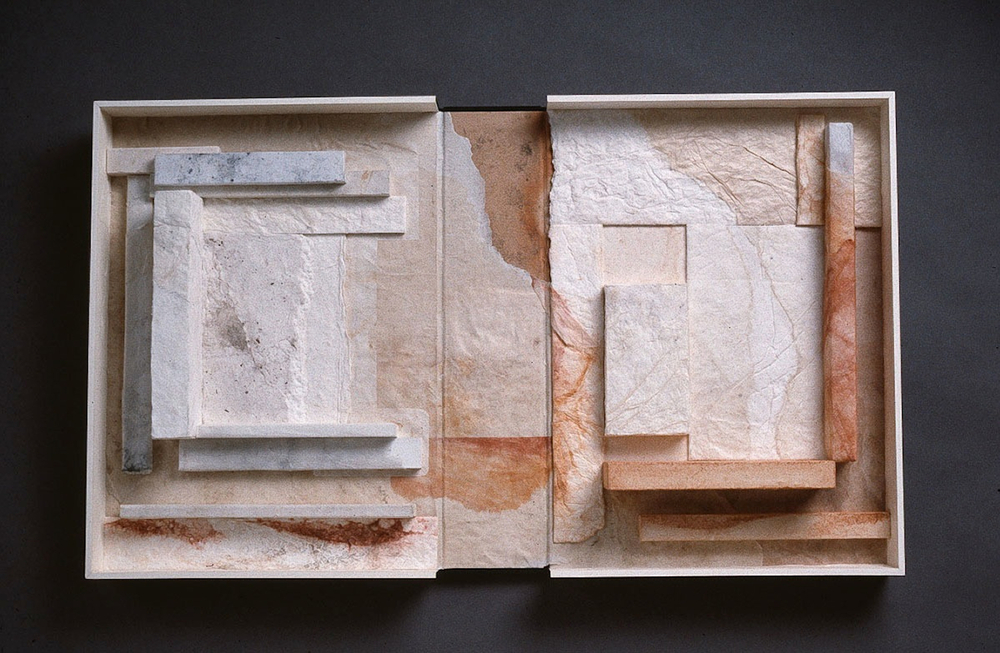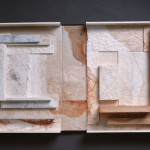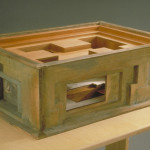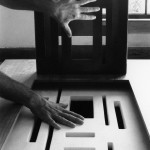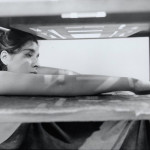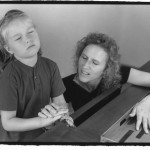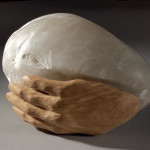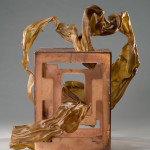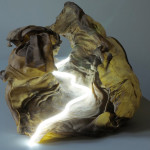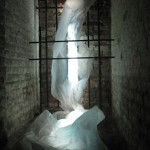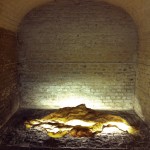I arrived at that observation after many years of working as an artist in two dimensions—first painting and then hand papermaking. Then in 1991, I made an artist’s book. This new form expanded my work into the third dimension, and at the same time into the tactile dimension. I was struck by the way a book has to be opened and handled to be known. So I made two book-like sculptures that could be turned over or opened, inviting people to engage the artwork with their hands.
At the same time I became interested in the experience of blindness. An artist friend gave a talk about her work, and afterward a man who was visually impaired said he wished she had described the images she had shown. I was amazed that someone who could not see would even be interested in art, and began wondering how people with little or no sight might experience works of art, which are considered the exclusive province of visual perception. Thinking about my book-sculptures, which could be handled and touched, I began to wonder if touch could convey the meaning of an artwork. Could touching be a way of knowing? That question, and the questions that followed, have informed my work ever since.
I knew nothing about touch in art, and could find nothing written on the subject, so I set out to explore the possibilities. I asked Deidre Muccio, a woman who is visually impaired, to visit art museums with me around New England and New York; we obtained permission from curators for her to touch selected sculptures, and sometimes I was also allowed to touch. Deidre had trained as a visual artist before losing her sight to an inherited retinal disorder in her twenties, but had bitterly closed the door on art years before. She had the courage to re-open it through her sense of touch. She had acquired tactile skills through living with visual limitations, but coming to know a work of art through touch called for an attitude of inquiry and openness. I watched her learn how to savor a sculpture through aesthetic touch. Like learning to see aesthetically, aesthetic touch involves a departure from habitual recognition and functional use; attention to formal elements such as shape, space and pattern; transformation of the object or situation into alternative structures, concepts, or meanings; and openness to the emotional, creative effects of one’s perceptions.
After a year of this research, I began making tactile sculptures. My intention was to create artworks that would be as legible to someone who could not see them as they would be to someone who could. This meant refraining from using purely visual phenomena such as light, shadow, transparency, reflection and color. Initially frustrated by these self-imposed limits, I soon realized I was trying to translate visual phenomena into tactile. I had to abandon my visual orientation and literally feel my way into this new aesthetic territory. Possibilities began to emerge. Materials became a substitute for color. Forms could have interiors or hidden places accessible to the hand but not visible to the eye. Textures grew more prominent and eloquent. Space became palpable. Transitions between materials or forms assumed new importance. Scale was grounded in the size and abilities of hands and body. Meanings were felt rather than conceived.
To gain a deeper understanding of what touch could and could not provide, I needed to gather feedback from a range of people. I showed these early sculptures in the Springfield Museum of Fine Art, deCordova Museum, Middlebury College Museum of Art and University of Arizona Museum of Art. Guided by Renee Wells, disability advocate, I offered sighted visitors blindfolds, designed guiding rails and audio tours, and trained docents for the exhibitions. Jeff Hayward, museum evaluator and director of People, Places and Design, collaborated with me to design and conduct interviews with people who explored the sculptures through touch while blindfolded. When we analyzed the results, we found people had remarkable experiences. Their comments did reveal a different way of knowing than seeing.
"It made me look at art in a new way, not from a distance, more involved, more intimate, more fun for the common person."
"There’s no one-to-one correspondence between tactile and visual realities; they are very different."
"I never knew that sight compresses time and space."
"At first I was afraid—how could I know? Then, on first touch, joy, a different kind of knowing."
From these interviews, as well as observing people exploring the sculptures, I learned the basic principles of tactile perception: touch is slow, linear, intimate, direct, connective and creative. Another central characteristic of touch is reciprocity; when we touch, we are also touched. When we touch a sculpture, it touches back. This reciprocal exchange creates a feeling of engagement and connection, a sense of dialogue. The artwork comes alive. Touching offers people their own experience of an artwork; the authority of their perceptions becomes the basis for understanding and meaning. Touch has an authenticity and concreteness that gives people confidence in their perceptions, cuts through physical and psychological distance, and disarms the notion many people have that they do not know enough about art to enjoy it.
"It brought me back down to earth, back into my individual psyche, using my own senses to form my reality in my surroundings."
Another key characteristic of touch is the motion implicated in touching; as we touch we also move, stimulating the inner senses that track the spatial location of our body parts as well as the quality and speed of our motion—smooth, jerky, tense or slow. This combination of touch and movement is called haptic perception, a more inclusive, global way of conceiving touch. Touching a sculpture, I translate its forms and spaces into motion, activating the artwork. My motions translate the sculpture into bodily experience, generating a more deeply felt understanding. Because movement produces sensations in the body, it can draw attention to the inner dimensions of being.
"Information taken in through the fingers was tactile and spatial, but it was a sense of space I have never experienced before because it was not made finite and given limits by visual measurement."
"I could feel sensations deep inside my body as I touched. And while exploring with my hands, memories of early spaces, of rooms, came into my mind. The air, the space that my hand had to travel from touch to touch became very palpable."
When we touch a sculpture, we invite movement and touch—which are normally unconscious—into conscious awareness and even into the realm of aesthetics and meaning. In so doing we create connections between conscious and unconscious aspects of our being, integrating higher and lower functions.
"It broke the lock, the hold that sight has on me. It got me off the highway that goes between eye and brain that you don't even know you're on. Wait a minute, you say, there's this whole other road to travel."
"If you look at a piece of art it's an object, but if you touch, it's a journey."
What we usually call touch is the place and moment of contact between a person and the world. Under that place of contact lie rich sensory realms that reach into the deepest parts of our bodies and our selves. Nerve receptors are embedded not only on the surface of the skin but also throughout the body. They lie in the deeper layers of skin where we feel pressure; in our muscles where we feel motion and bodily presence; in the joints where we feel movement and spatial location; and deeper still, in the visceral core where we feel emotions and gut response. Together, these sensory modes are called the somatic senses, a term that conveys the complex, diffuse, embodied nature of the somatosensory system. The somatic senses also include temperature, balance, pain and pleasure.1 What these sensory powers have in common is the capacity to reveal the conditions of the body-mind, conditions affected by one’s environs as well as by activity within the body or mind. The somatic senses often tell us more about the interior conditions of the body-mind and the impact of external things than about the things themselves. By their very structure and function, the somatic senses span outer and inner dimensions.
Aesthetic touch draws from this deep well of sensory experience. It conveys impressions of what we are touching as well as the conditions of the person who is doing the touching. Touching fuses the world around me with the world within me. When I wrap my arms around a Rodin figure, I feel the textures of the smooth surfaces, know the hardness and warmth of marble, and measure the dimensions of the figure with my body. I also feel the folding of my arms, the curve of my shoulders, and the agility of my hands. Exploring the qualities of the sculpture reveals my own qualities: the hardness of marble contrasts with my soft flesh; the sculpture’s stillness heightens my mobility; the smoothness reminds me of my skin. These somatic perceptions trigger a spectrum of feelings and memories. Touching the sculpture’s surfaces might feel like touching another person, the stillness might feel calming, the solidity reassuring.
Touch is essential for human survival and well-being, from earliest childhood until the day we die, and so is linked to pleasure, pain, sexuality, visceral feelings, and emotional states. By integrating the sense of touch into the experience of art, we tap into these deeply felt, often unconscious responses, which feed into the aesthetic experience. Bodily history, habits, drives and passions come into play.
"This experience is very fundamental, basic, primitive, more direct than intellectual experiences and therefore stronger."
Even for adults, touch remains colored by early experiences as children when touch was the primary way of interacting with the world, and assurance and comfort were afforded by tactile exchanges with the mother. Touching—even of sculpture—is infused with memories of the polymorphous pleasures of childhood. Sculptures are often unfamiliar objects made of sensuous, appealing materials; touching allows us to know them the way we came to know things as children. Artists employ such playful, open investigation; touching is a way for people to tap into that sense of curiosity and to re-connect with their childhood pleasure.
"There was such a sense of freedom: no barriers, no age, no survival, just bliss. Permission! Being a kid! Atavistic. A return to childhood."
The ease and frequency of touching and being touched that occurs in childhood diminishes as we mature. Conscious, sensuous touch can eventually become limited to sexual encounters. Touching sculpture may call up sexual associations, even if the artwork is not figurative. Touch, sex and pleasure can become linked in a trio that excludes other kinds of tactile exchange or sensuous pleasure, reducing sensitivity and openness to tactility. This state of affairs makes touching sculpture potentially charged, intensifying the encounter.
"I never considered touching in another atmosphere than the intimate."
"Sight is safe, touch is erotic."
Apart from the erotic or pleasurable aspects of sexual relations, their mutuality is shared by the reciprocal nature of touch. When we touch, we are touched; we are intimately engaged, even with a work of art. Mutuality and reciprocity underlie touch; we cannot remain aloof, apart, detached or at a distance, as we can with sight.
"It’s all about relationship. When I touch, I enter into a relationship with what I’m touching. I can’t remain with my superficial ideas of what something is. I’m invited to go deeper."
Such close engagement can incite pleasure but also discomfort. Touch brings us into contact with things that can hurt us; risk and vulnerability underlie the experience of touching sculpture. I had to make my sculptures safe to touch, since people trusted they would not be hurt. Touching also makes us psychologically vulnerable. We open ourselves to the possibility of disturbing as well as pleasurable feelings. Tactile sensations can easily trigger the sensations of emotions, both being bodily in nature. I learned that fear and exhilaration can result from people encountering edges, holes, sudden transitions, unexpected materials, or even open spaces. Engaging with art provides an opportunity to feel emotions in an aesthetic context, where we refrain from acting on our feelings and are free to explore them in depth.
"There are so many emotions attached to the closeness and innocence of touch."
"Such a dynamic experience, very deep with curiosity and anxiety."
Touching sculpture grounds emotions in sensations, giving feelings an immediacy and reality that renders them more accessible: a steel passage feels cold, making me fearful; a wooden area feels warm so I relax; a leather hammock is reassuring; a tight fit causes panic; a keen edge worries me.
"And gravity! My stomach and guts got involved. When I touched the cloth that was wrapping something vertical, I felt nausea. I love the way things wiggle when suspended. I like having to squat down."
Touching deeply defines one’s sense of self, shaping the maps of our bodies that are generated in the brain. I learn who and how I am through my motions and interactions with the world. When I touch a sculpture—a complex, articulate object—I learn even more. Touching sculpture provides contact with unusual materials, unfamiliar sensations, new movement patterns, and opportunities for empathy and emotional exploration.
"The worked aluminum surface felt softer than paper. Copper felt softer than wood, more impressionable. Astonishing that such a hard surface could feel so soft; it seemed softer than my skin."
"When I got to a place that went deeper, it felt like an infinite cavity, and that felt risky."
"If you look at a piece of art it's an object, but if you touch it, it's a journey."
Complex and compelling, touching fuses outer and inner realities by alerting us to the conditions of the environment and the conditions within us. The effects of touch ripple inward and outward, forging a unified sensory field. In this merging of inner and outer conditions, touch mirrors the role of art. Art also gives us access to inner and outer dimensions of both world and self, forging a unified aesthetic field. Artworks explore and describe the larger world, portraying people, landscapes, religions, cultures and passions. They convey different ways of perceiving, expressing, and being. They explore the laws of nature and how to play with, contradict, or up-end them. They reveal form, structure, order, boundaries, relationships, movement and color. At the same time artworks take us into our inner worlds, summoning our personal histories, memories, emotions, and imaginations. They evoke feelings, images and qualities that may lie unnoticed, unformed and inarticulate until catalyzed by a work of art. They reveal us to ourselves, reflecting back to us who we are by what we find in them. Artworks introduce parts of our selves to each other. They alter our perceptual expectations and habits. They teach us new ways to order, structure and live our lives. By opening ourselves to works of art, we sense more clearly the contours of our inner landscapes. When the approach to art is augmented by the use of touch, which also fuses inner and outer conditions, art and touch magnify each other’s powers. Both art and touch cross boundaries of self, time and space to connect us deeply with the world and with ourselves. This commonality makes touch remarkably effective for the experience of art.
The tactile sculptures that I made during this period have architectonic structures, which orient people’s exploration and allow hands to enter them and to feel what could sometimes not be seen. Because I needed durable, sensuous materials, I turned to bronze, steel, stone and wood, which I had not used before and which had intrinsic qualities and associations I could take advantage of. I wanted the works to be the size that bodies could encompass, so scale took on new meaning and immediacy. The possibility of different kinds of touch—delicate, grasping, sliding—encouraged me to make elements that would support a range of tactile responses. I wanted to invite different kinds of movement—reaching above or below, sweeping gestures, or embracing—so I consciously made forms that extended into space or curved or contained.
During the early stages of my evolving understanding of touch, I separated it from sight. I even removed sight (through the use of blindfolds) to sequester its normal dominance. In playing up the role of touch in my thinking, speaking and writing, I played down the powers of sight. I railed against sight’s distant, swift, centralized, disembodied, objectifying, conceptualizing characteristics—the very qualities that have wreaked such havoc in our society. To champion touch felt like an act of resistance, an assertion of more grounded, relational, reciprocal, embedded, embodied values. The two senses came to represent for me the two poles of human existence.
In my desire to understand touch, I cast the differences between sight and touch as antagonistic, and touted touch as superior. This strategy proved to be a stage in my development. The contest between sight and touch evolved into a more integrative, realistic understanding. I came to acknowledge that when sight is present, tactile qualities are frequently subsumed and overwhelmed by visual perception (depending on the circumstances and one’s intention).
I also had to admit that touch is normally unconscious, especially compared to the more conscious perceptions of sight. I was trying to make the haptic experience conscious, not only for my own understanding, but also for viewers. Lifting tactile/haptic perception to conscious awareness was fruitful for the purpose of my research, for the artworks I was making, and for people willing to move through the exhibitions blindfolded. However, viewers could only gain the full effects of the tactile experience by temporarily occluding sight, in order to isolate, highlight, and focus on the nature of touch. The use of blindfolds, guiding rails and audio tours to make touch more accessible and more conscious began to feel contrived and cumbersome. I was working against the grain of normal perception.
I was also working against the grain of art museum policy, which prohibits touching. Having worked for several years in art museums, I was sympathetic to the prohibition, but felt there was room for occasional, appropriate touching of selected artworks, especially artworks created for touch. I discovered the degree to which the prohibition has indiscriminately infused the culture of art as I continued to encounter skepticism and reluctance to include touch, even among artists who could reasonably allow people to touch their art if they so wished. I came to realize that many artists, let alone curators, did not share my passion for tactile/somatic investigation.
Eventually I began to wonder how to account for all the artworks that could never be touched because they are too large, small, fragile, rare or valuable. And what about all the artworks that reveal little or nothing to actual touch? Could there be a way that tactile, haptic, somatic experiences could be stimulated through seeing? Could the somatic responses I was observing in people when they touched be integral to the visual experience of art?
Now that I was tuned to the body’s responses, I came to recognize that these responses were not necessarily limited to haptic encounters. I had to acknowledge that seeing is often infused with the somatic senses, just as touching draws on visual memory and imagination. Under the dazzling optical surfaces of visual art lies a rich panoply of somatosensory responses—haptic, kinesthetic, proprioceptive, visceral and emotional. We think of our experience of visual art as visual in nature. Yet the body is always the matrix of the aesthetic encounter. As we look at an artwork, our somatic senses are measuring its size and scale, remembering how materials feel to the touch, subtly miming the gestures that made the marks, opening to the warmth or chill of color, and imagining being inside the forms and spaces. We feel in our bodies whether something is massive or delicate, heavy or light, balanced or precarious, orienting or disorienting, organized or chaotic, rhythmic or staccato, rough or smooth, open or closed, protective or vulnerable, inviting or threatening. These responses are somatic in nature, not only visual. We know these qualities from a lifetime of living in the body.2 They are fundamental human perceptions applied to the special conditions of an artwork.
Acknowledging the somatic dimensions of the visual experience opens new ways of perceiving works of art. By listening to the body, one gains access to the cues an artwork offers. Learning to look at art can include learning to pay attention to, and to trust, these largely unconscious perceptions. This approach provides direct access to one’s responses, regardless of how much one knows or doesn’t know about art.
Looking at a work of art is an act of empathy. We now know that empathy has a neurological substrate, arising as we unconsciously mirror or simulate the motions and emotions of people and animals or their surrogates. When we see someone moving, we mimic their motion in the motor system of our own brains, but without actually moving. When we see someone crying, we often feel a corresponding sadness. Our capacity to make sense of the actions, emotions and sensations of others depends on embodied simulation—as if we were engaged in a similar action or experiencing a similar emotion or sensation. The discovery of these mirror neurons by neuroscientists provides an explanation for empathetic responses to art as well as to people. Embodied simulation enables direct experiential understanding of the intentional and emotional contents of images.3 At a subtle proprioceptive level, we feel the attitudes and tensions within a sculpture as we subliminally respond to those forces, forms, or spaces. We can also identify with an artwork, imagining ourselves as inside it or as part of it or as equivalent to it. We feel—and therefore know—the thrust of a figure’s gesture, the arc of a brushstroke, the expansiveness of a space. A rich, silent dialogue between body-mind and artwork deeply informs the aesthetic experience, whether we are conscious of it or not. Art is made and experienced by hand, body and heart as well as by eye and mind.
To learn more about this somatic dimension of visual art, in 2011 I turned again to interviewing people, as I had when I first began exploring aesthetic touch twenty years before. For this new round of investigation, I am focusing on specific aspects of people’s experience—the sensory and somatic—while remaining open to any response. This kind of research became possible when I met Claire Petitmengin, a French philosopher who has developed a sophisticated, rigorous interview method called elicitation interview.4 Her sensitive, probing, in-depth questions enable people to gain access to their pre-reflective, inner experiences and to re-experience and describe them in remarkable detail. Petitmengin is a philosopher and protégé of neurobiologist Francisco Varela, who argued that the study of the mind has to include the subjective, experiential dimension along with the objective, observable, measurable dimensions used by science. This interview method can be applied to any subjective experience, but proves an excellent tool for revealing the nature and contours of the aesthetic encounter, which is complex, personal, multivalent, idiosyncratic and meaningful.
Petitmengin interviewed visitors to an exhibition I co-created as a member of Sensory Sites, an international collective dedicated to multisensory installations, in the Crypt Gallery in London, during the spring of 2011. (See www.artintouch.com) After their visit to the exhibition, interviewees chose two or three moments to recall, re-experience and describe. We were looking for evidence that perceiving art engages the whole body, and is not only a matter of visual perception. Petitmengin’s questions gently encouraged the interviewees to remember and describe their experiences (not think about, speculate, associate with, justify or explain them) down to the details of bodily reactions and physical sensations. Their descriptions confirmed our conviction that the encounter with art can be somatic as well as visual. This was no surprise, since we were intentionally offering highly sensory, somatic experiences in the exhibition to stimulate psychosomatic responses. The entire environment of the Crypt spoke to all the senses, from the approach to the gallery under the caryatids of the church architecture, through the weight of the huge bronze doors at the entrance, down the steep stone steps, across uneven stone floors, and into a maze of chambers and passages in the dark, dank atmosphere. The various installations in the chambers offered sensory worlds to enter, including immersive moving images, sound and light, and opportunities to touch sculptures. We not only created multisensory installations, but also embedded them in a context that was already rich in sensory stimuli and rife with meaning.
We are still processing and analyzing the interviews, but I can share the framework and some preliminary observations. We approached our exhibition and the analysis of the interviews through a series of questions. These questions are too large to "answer" but they indicate the direction of our interest and the nature of the responses elicited in the interviews.
1. Does seeing trigger bodily responses such as sensations, disorientation, pleasure?
That seeing generates somatic responses was corroborated by our interviewees (as well as by scientists). We cannot say that mirroring or simulation is in play, but the responses indicated that the body is affected by what it sees. It also became apparent from the responses that bodily sensations are hard to distinguish from emotions.
"It’s the sheer pleasure of seeing all those different shapes, over and over…and …the rhythm of it, the rhythm of the shapes."
"I wouldn’t say I was winded, but something close to that, like I was knocked by that powerful dark, wrinkled, hard but fluid thing."
"The sight of it is not so much…it’s the feel of it that overtakes."
2. What is the connection between sensory responses and emotions?
Emotions are sensations, so we expected the overlap of sensation and emotion, but we did not expect the degree to which sensations shade into emotions; sensory responses often had emotional undertones or overtones. Sensory input was often expressed as feelings, qualities of being, or sensations that carried emotional implications. For example, space that was described as cramped and bounded was further translated into the feeling of being trapped. The cascade of sight-triggered sensations and emotions took place so swiftly they were experienced as if fused.
"It was as if I were moving into a wave…and the wave came into me so there was that quality of meeting. It was like being washed inside, becoming clean."
"And the feeling of the intrusion was very strong, the feeling of being invaded by something else, the feeling of being open, without defense."
"That work reminds me of muscles and tendons being pulled and stretched in a very difficult, contorted way and that works very well with this smell, which give me a very uncomfortable, very strained feeling."
3. What role do empathy, identification and projection play in the aesthetic experience?
Empathy seems to be the basis for the somatic responses people reported—or perhaps the somatic responses could be said to generate empathy. Some people said they identified with elements in the installation, imagining how they would feel if they were an object or a situation. Some people were so struck by particular elements, or the whole of an artwork, that they temporarily incorporated them into their imagined body-image.
"It was on the surface of the sculpture but it looked as if it were inside it, going through it, so it felt as if it were going through me."
"There is a point where you, your body and the object become one thing."
4. How are people’s body images or schema affected by their experiences?
Changes in people’s sense of their size, shape and boundaries were a common response—the impression of the body image changing as the environment changed. Some people used their whole bodies perceptually.
"The sculpture is body-sized, so it’s very much as if I were it."
"These plant-like structures were, were much larger than they would be in life, so they made me feel quite small. Not tiny, but something like a child walking between tall trees."
5. Can the space around an artwork be integral to its meaning?
The maze-like exhibition, with its chambers, rooms and passages, offered distinctly different qualities in each area. Space was not reported as an abstract, measurable entity but as bodily experience and emotional response. Spatial context became integral to the experience of the artwork. People observed the shape of a space and its limits, and described the relationship between their bodies and the space. Spaces acquired sensuous, animate qualities.
"[This feeling of awe] is much more a whole body feeling because it’s my body in relation to the space around me. It doesn’t feel as though it has very fast, very firm boundaries, so I think it’s something to do with merging with the space around."
"It’s big enough that I can’t sense the boundaries of it, like being in a wood, where you don’t quite know where the ends of the woods are."
6. Do people develop strategies and frameworks for organizing and understanding their experience?
People who were interviewed took different approaches to the exhibition, tending to build consistent, coherent experiences from their overarching attitudes, moods, intentions, strategies, and ways of conceiving and perceiving. Some people sought to name, categorize, and make sense of their experience through conceptual understanding. Some people took an investigative approach, seeing the artworks as puzzles to solve or conditions that would reveal more through attention and interest. Some people approached the exhibition with a playful attitude, allowing themselves to adopt a child-like openness to what they found. Each approach shaped how people perceived the materials and forms, how they generated meaning, and how they interpreted their experience.
"I had a sense of wanting to disturb what was given to me. To make an impact on it, interact with it."
"I wanted to explore, like when I was young and playing in the woods and the light was kind of coming in through dappled leaves, and this dark space in the tunnel, so I was quite excited."
"One piece is very rounded, very soft and the other nearby is very contorted, and jagged, very sharp, and together they were so different, so they worked as opposites for me in the show. One was more controlled, and the other was more enforced, sort of an attack."
Our exhibition was immersive and multisensory by intention, design and execution, and therefore ripe material for such responses. Yet similar responses occur in the encounter with other kinds of sculpture, with architecture, with paintings, prints and photographs, and with moving images. Many artists work directly with the body’s responses, such as Turell, Serra, Abakanowicz and Giacometti, to name a few. I am drawn to these artists’ work for that very reason, though they create quite different effects. Turrell offers a lightness of being and absence of boundaries utterly different than Abakanowicz’ earthy, bodily, gestural presences that feel as if they were animal. Serra speaks to the body through sheer scale, encompassing spaces and intense physicality, while Giacometti’s sculptures ask me to feel the struggle of their making and the core of my body.
Although I call myself a visual artist, I recognized long before the tactile work that my primary mode of perception is proprioceptive sensing, feeling in the body. Some people will have easier access to this dimension of their experience than others. Some artworks will provoke such experiences more fully than others. Yet I think the recognition of this dimension of the visual experience yields exciting possibilities, and will be investigated further by artists, art educators, critics, curators, art historians and museum designers as well as by scientists and psychologists. Once again, I am pointing to an aspect of the aesthetic experience that remains largely unconscious. However, consciously acknowledging, exploring, and plumbing the somatic dimensions of the experience of art can deepen our understanding of the visual experience, open new avenues for artistic expression, and alter how we see and think about art.

Rosalyn Driscoll, Rivers of Hades: Lamentation (Cocytus), 2011, Rawhide, 1’ x 7’ x 3’
- Rosalyn Driscoll, Breathing Ground, 1992, Handmade paper, wood, cloth, 3.5″ x 20″ x 15″
- Rosalyn Driscoll, House, 1993, Bronze, wood, leather, handmade paper, 8″ x 25″ x 17″
- Rosalyn Driscoll, Elegy 1, 1995, Wood, marble, schist, steel, handmade paper, 53″ x 31″ 50″
- Rosalyn Driscoll, Elegy 5, 1996, Steel, stone, leather, rope, gauze, 52″ x 32″ x 52″
- Rosalyn Driscoll, Elegy 5, 1996, Steel, stone, leather, rope, gauze, 52″ x 32″ x 52″
- Rosalyn Driscoll, Rafael, 2001, Alabaster, wood, 7″ x 10″ x 8″
- Rosalyn Driscoll, Pandora’s Box 9, 2007, Coppered steel, rawhide, 30″ x 26″ x 28″
- Rosalyn Driscoll, Emptiness of Fire, 2010, Rawhide, neon, 12″ x 41″ x 17″
- Rosalyn Driscoll, Rivers of Hades: Meaninglessness 2011, Paper, wood, light, 6″ x 2″ x 6″
- Rosalyn Driscoll, Rivers of Hades: Lamentation (Cocytus), 2011, Rawhide, 1″ x 7″ x 3″
[1] David Katz, Ed. and trans. by Lester E. Krueger, The World of Touch (Hillsdale, NJ: Lawrence Erlbaum Associates, 1989)
[2] George Lakoff and Mark Johnson, Metaphors We Live By (Chicago: University of Chicago Press, 1980)
[3] Sandra Blakeslee and Matthew Blakeslee, The Body Has a Mind of its Own (NY: Random House, 2007)
[4] Claire Petitmengin, ed. Ten Years of Viewing from Within: the Legacy of Francisco Varela (Imprint Academic, 2009)
A bibliography for further reading is listed under "Resources" on the artist's website.
Other articles Driscoll has published include:
Sculpture and Touch, Peter Dent, ed, "Playing with Fire" (London: Ashgate Press, 2012 forthcoming)
The Hand: An Organ of the Mind, Z. Radman, ed. "Rehabilitating the Hand" (MIT Press, 2013)
Art and the Senses, Francesca Bacci and David Melcher, ed., "Aesthetic Touch" (Oxford University Press, 2011)
Artesian, "Aesthetic Touch" Autumn/Winter 2008

